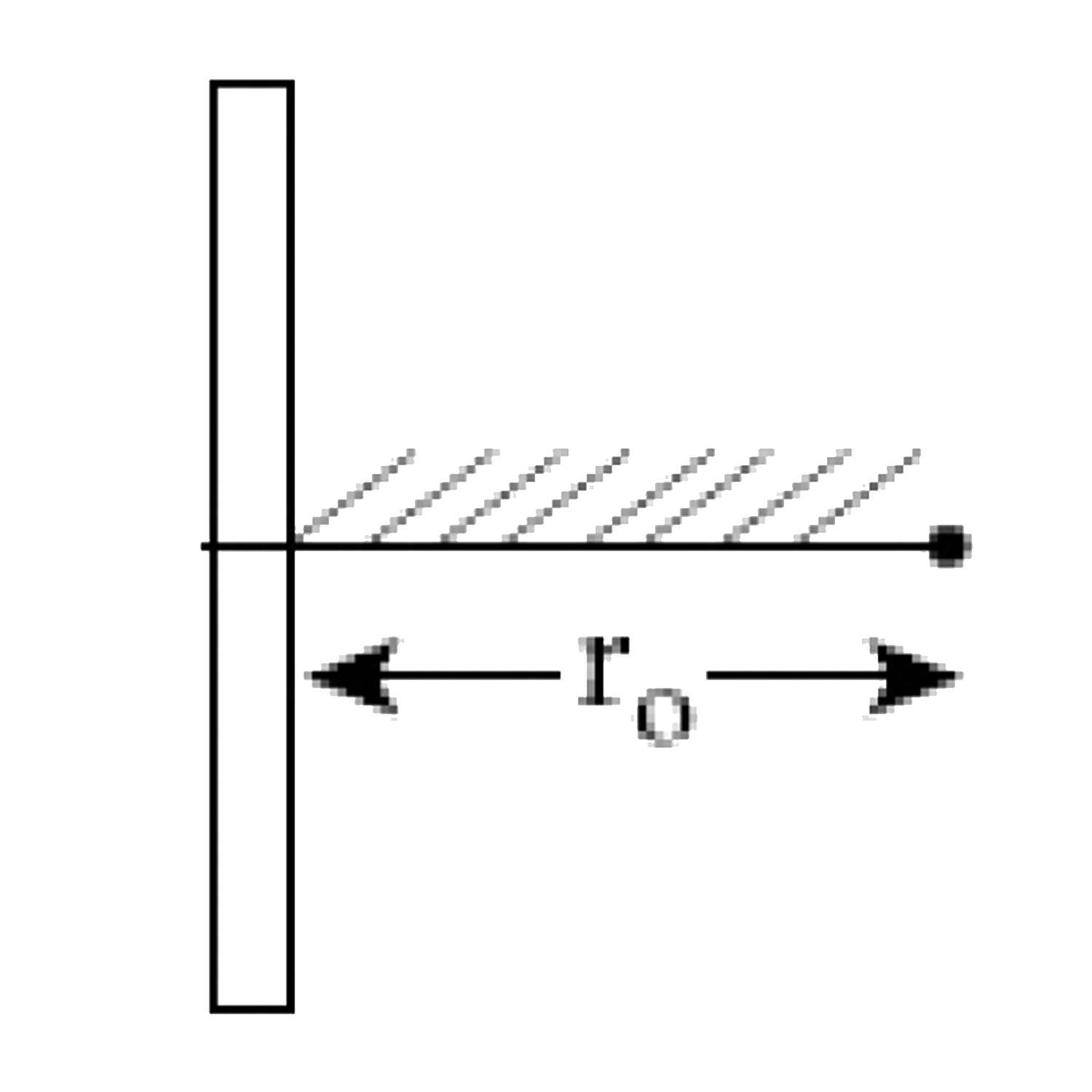A particle of mass 40 mg and carrying a charge 5×10−9C is moving directly towards a fixed positive point charge on magnitude 10−8C. When it is at a distance of 10 cm from the fixed positive point charge it has a velocity of 50cms−1 at what distance from the fixed point charge will the particle come momentarily to rest ? Is the acceleration constant during motion?
To solve the problem step by step, we will apply the principle of conservation of mechanical energy.
Given Data:
- Mass of the particle, m=40mg=40×10−6kg
- Charge of the particle, q1=5×10−9C
- Fixed positive charge, q2=10−8C
- Initial distance from the fixed charge, r1=10cm=0.1m
- Initial velocity, v1=50cm/s=0.5m/s
Step 1: Calculate Initial Kinetic Energy
The initial kinetic energy (KE1) of the particle can be calculated using the formula:
KE1=12mv21
Substituting the values:
KE1=12×40×10−6×(0.5)2=12×40×10−6×0.25=5×10−6J
Step 2: Calculate Initial Potential Energy
The initial potential energy (PE1) when the particle is at a distance of r1 from the fixed charge can be calculated using the formula:
PE1=kq1q2r1
Where k=9×109N m2/C2. Substituting the values:
PE1=9×109×(5×10−9)(10−8)0.1=9×109×5×10−170.1=4.5×10−6J
Step 3: Total Initial Energy
The total initial energy (E1) is the sum of kinetic and potential energy:
E1=KE1+PE1=5×10−6+4.5×10−6=9.5×10−6J
Step 4: Final Potential Energy
Let r2 be the distance from the fixed charge where the particle comes momentarily to rest. At this point, the kinetic energy is zero (KE2=0), and the potential energy (PE2) is given by:
PE2=kq1q2r2
The total energy at this point is:
E2=KE2+PE2=0+PE2=PE2
Step 5: Set Total Energies Equal
Since energy is conserved, we have:
E1=E2
Thus,
9.5×10−6=kq1q2r2
Substituting the values:
9.5×10−6=9×109(5×10−9)(10−8)r2
Rearranging gives:
r2=9×109×5×10−179.5×10−6
Calculating r2:
r2=45×10−89.5×10−6=4.7368m≈4.73m
Conclusion
The distance from the fixed point charge where the particle will come momentarily to rest is approximately 4.73m.
- Mass of the particle, m=40mg=40×10−6kg
- Charge of the particle, q1=5×10−9C
- Fixed positive charge, q2=10−8C
- Initial distance from the fixed charge, r1=10cm=0.1m
- Initial velocity, v1=50cm/s=0.5m/s
The initial kinetic energy (KE1) of the particle can be calculated using the formula:
KE1=12mv21
Substituting the values:
KE1=12×40×10−6×(0.5)2=12×40×10−6×0.25=5×10−6J
The initial potential energy (PE1) when the particle is at a distance of r1 from the fixed charge can be calculated using the formula:
PE1=kq1q2r1
Where k=9×109N m2/C2. Substituting the values:
PE1=9×109×(5×10−9)(10−8)0.1=9×109×5×10−170.1=4.5×10−6J
The total initial energy (E1) is the sum of kinetic and potential energy:
E1=KE1+PE1=5×10−6+4.5×10−6=9.5×10−6J
Let r2 be the distance from the fixed charge where the particle comes momentarily to rest. At this point, the kinetic energy is zero (KE2=0), and the potential energy (PE2) is given by:
PE2=kq1q2r2
The total energy at this point is:
E2=KE2+PE2=0+PE2=PE2
Since energy is conserved, we have:
E1=E2
Thus,
9.5×10−6=kq1q2r2
Substituting the values:
9.5×10−6=9×109(5×10−9)(10−8)r2
Rearranging gives:
r2=9×109×5×10−179.5×10−6
Calculating r2:
r2=45×10−89.5×10−6=4.7368m≈4.73m
The distance from the fixed point charge where the particle will come momentarily to rest is approximately 4.73m.
Topper's Solved these Questions
- ELECTROSTATICSBOOK - RESONANCE ENGLISHCHAPTER - ELECTROSTATICSEXERCISE - Problems
22 Videos
- ELECTROSTATICSBOOK - RESONANCE ENGLISHCHAPTER - ELECTROSTATICSEXERCISE - Exercise-1 Section (A)
9 Videos
- ELECTROMAGNETIC INDUCTIONBOOK - RESONANCE ENGLISHCHAPTER - ELECTROMAGNETIC INDUCTIONEXERCISE - A.l.P
19 Videos
- EXPERIMENTAL PHYSICSBOOK - RESONANCE ENGLISHCHAPTER - EXPERIMENTAL PHYSICSEXERCISE - PART -II
10 Videos
Similar Questions
Knowledge Check
A body has a positive charge of 8×10−19C. It has :
Aan excess of 5 electronsBa deficiency of 5 electronsCan excess of 8 electronsDa deficiency of 8 electrons
find the electric field strength due to a point charge of 5μC at a distance of 80 cm from the charge.
View SolutionA particle of mass 100 gm and charge 2μC is released from a distance of 50 cm from a fixed charge of 5μC. Find the speed of the particle when its distance from the fixed charge becomes 3 m.
View SolutionTwo point charge Q and 4Q are fixed at a distance of 12cm from each other. Sketch lines of force and locate the neutral point, if any .
View SolutionA water particle of mass 10.0 mg and having a charge of 1.50×10−6C stays suspended in a room. What is the magnitude of electric field in the room ? What is its direction?
View SolutionAn infinite line charge produces a field of 7.182×108N/C at distance of 2 cm. the linear charge density is
View SolutionA positive charge is released from rest at a distance r0 from a positive line charge with uniform density . The speed (v) of the point charge , as a function of instantaneous distance r from line charge, is proportional to:

View SolutionThe electric intensity due to a dipole of length 10cm and having a charge of 500μC, at a point on the axis at a distance 20cm from one of the charges in air is
View Solution
